Skyrmions open a door to next-level data storage
Knots in magnetic materials could one day make for faster, sturdier, tinier electronics
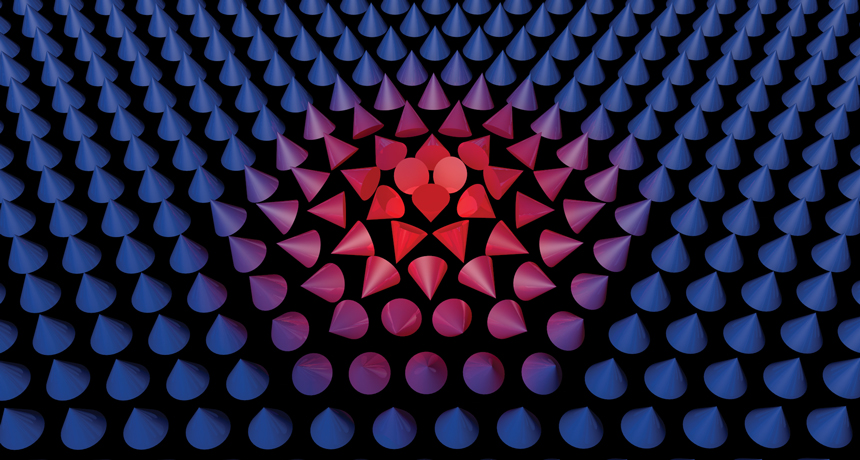
Knots in magnetic materials could one day make for faster, sturdier, tinier electronics
MAGNETIC KNOTS A skyrmion is a swirl (red) among the atoms of a magnetic material. Here, cones point in the direction of each atom’s magnetization. Skyrmions come in several types; this one, a Néel skyrmion, is found in thin materials.
ELLA MARU STUDIO
Magazine issue: Vol. 193, No. 3, February 17, 2018
EmailPrintTwitterFacebookRedditGoogle+
SPONSOR MESSAGE
Like sailors and spelunkers, physicists know the power of a sturdy knot.
Some physicists have tied their hopes for a new generation of data storage to minuscule knotlike structures called skyrmions, which can form in magnetic materials. Incredibly tiny and tough to undo, magnetic skyrmions could help feed humankind’s hunger for ever-smaller electronics.
On traditional hard drives, the magnetic regions that store data are about 10 times as large as the smallest skyrmions. Ranging from a nanometer to hundreds of nanometers in diameter, skyrmions “are probably the smallest magnetic systems … that can be imagined or that can be realized in nature,” says physicist Vincent Cros of Unité Mixte de Physique CNRS/Thales in Palaiseau, France.
What’s more, skyrmions can easily move through a material, pushed along by an electric current. The magnetic knots’ nimble nature suggests that skyrmions storing data in a computer could be shuttled to a sensor that would read off the information as the skyrmions pass by. In contrast, traditional hard drives read and write data by moving a mechanical arm to the appropriate region on a spinning platter (SN: 10/19/13, p. 28). Those moving parts tend to be fragile, and the task slows down data recall. Scientists hope that skyrmions could one day make for more durable, faster, tinier gadgets.
One thing, however, has held skyrmions back: Until recently, they could be created and controlled only in the frigid cold. When solid-state physicist Christian Pfleiderer and colleagues first reported the detection of magnetic skyrmions, in Science in 2009, the knots were impractical to work with, requiring very low temperatures of about 30 kelvins (–243° Celsius). Those are “conditions where you’d say, ‘This is of no use for anybody,’ ” says Pfleiderer of the Technical University of Munich.
Skyrmions have finally come out of the cold, though they are finicky and difficult to control. Now, scientists are on the cusp of working out the kinks to create thawed-out skyrmions with all the desired characteristics. At the same time, researchers are chasing after new kinds of skyrmions, which may be an even better fit for data storage. The skyrmion field, Pfleiderer says, has “started to develop its own life.”
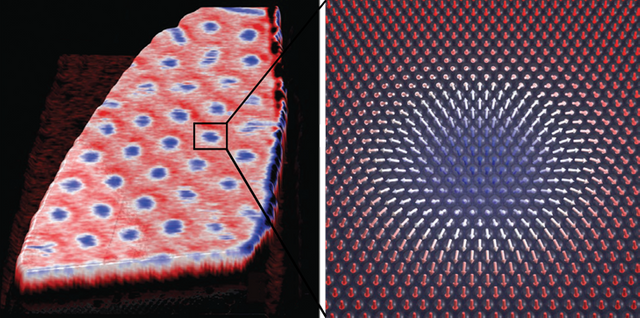
A grid of skyrmions (blue circled by white) is revealed in an ultrathin film of palladium and iron, in this image from a scanning tunneling microscope (left) and illustrated inset of a single skyrmion (right).
K. VON BERGMANN
Memories in magnets
In a magnetic material, such as iron, each atom acts like a tiny bar magnet with its own north and south poles. This magnetization arises from spin, a quantum property of the atom’s electrons. In a ferromagnet, a standard magnet like the one holding up the grocery list on your refrigerator, the atoms’ magnetic poles point in the same direction (SN Online: 5/14/12).
Skyrmions, which dwell within such magnetic habitats, are composed of groups of atoms with their magnetic poles oriented in whorls. Those spirals of magnetization disrupt the otherwise orderly alignment of atoms in the magnet, like a cowlick in freshly combed hair. Within a skyrmion, the direction of the atoms’ poles twists until the magnetization in the center points in the opposite direction of the magnetization outside. That twisting is difficult to undo, like a strong knot (SN Online: 10/31/08). So skyrmions won’t spontaneously disappear — a plus for long-term data storage.
Using knots of various kinds to store information has a long history. Ancient Incas used khipu, a system of knotted cord, to keep records or send messages (SN Online: 5/8/17). In a more modern example, Pfleiderer says, “if you don’t want to forget something then you put a knot in your handkerchief.” Skyrmions could continue that tradition.
GIVE IT A WHIRL Skyrmions move across magnetic material by sliding from atom to atom. Here, each atom is indicated by a cone that points in the direction of its magnetization. As the swirl travels, atoms stay in place, but their magnetic poles rotate. Skyrmions may be a future option for fast, sturdy, small data storage.
On the right track
Skyrmions are a type of “quasiparticle,” a disturbance within a material that behaves like a single particle, despite being a collective of many individual particles. Although skyrmions are made up of atoms, which remain stationary within the material, skyrmions can move around like a true particle, by sliding from one group of atoms to another. “The magnetism just twists around, and thus the skyrmion travels,” says condensed matter physicist Kirsten von Bergmann of the University of Hamburg.
In fact, skyrmions were first proposed in the context of particles. British physicist Tony Skyrme, who lends his name to the knots, suggested about 60 years ago that particles such as neutrons and protons could be thought of as a kind of knot. In the late 1980s, physicists realized the math that supported Skyrme’s idea could also represent knots in the magnetization of solid materials.
Such skyrmions could be used in futuristic data storage schemes, researchers later proposed. A chain of skyrmions could encode bits within a computer, with the presence of a skyrmion representing 1 and the absence representing 0.
In particular, skyrmions might be ideal for what are known as “racetrack” memories, Cros and colleagues proposed in Nature Nanotechnology in 2013. In racetrack devices, information-holding skyrmions would speed along a magnetic nanoribbon, like cars on the Indianapolis Motor Speedway.
Solid-state physicist Stuart Parkin proposed a first version of the racetrack concept years earlier. In a 2008 paper in Science, Parkin and colleagues demonstrated the beginnings of a racetrack memory based not on skyrmions, but on magnetic features called domain walls, which separate regions with different directions of magnetization in a material. Those domain walls could be pushed along the track using electric currents to a sensor that would read out the data encoded within. To maximize the available space, the racetrack could loop straight up and back down (like a wild Mario Kart ride), allowing for 3-D memory that could pack in more data than a flat chip.
Drive it
In a “racetrack” memory, skyrmions could be created to represent a 0 or 1. Pushed by an electric current, the magnetic whorls would travel to a sensor to be read. Squeezing the track into loops (inset) would store data in less space.
T. TIBBITTS
Source: S. Krause and R. Wiesendanger/Nature Materials 2016
“When I first proposed [racetrack memories] many years ago, I think people were very skeptical,” says Parkin, now at the Max Planck Institute of Microstructure Physics in Halle, Germany. Today, the idea — with and without skyrmions — has caught on. Racetrack memories are being tested in laboratories, though the technology is not yet available in computers.
To make such a system work with skyrmions, scientists need to make the knots easier to wrangle at room temperature. For skyrmion-based racetrack memories to compete with current technologies, skyrmions must be small and move quickly and easily through a material. And they should be easy to create and destroy, using something simple like an electric current. Those are lofty demands: A step forward on one requirement sometimes leads to a step backward on the others. But scientists are drawing closer to reining in the magnetic marvels.
Heating up
Those first magnetic skyrmions found by Pfleiderer and colleagues appeared spontaneously in crystals with asymmetric structures that induce a twist between neighboring atoms. Only certain materials have that skyrmion-friendly asymmetric structure, limiting the possibilities for studying the quasiparticles or coaxing them to form under warmer conditions.
Soon, physicists developed a way to artificially create an asymmetric structure by depositing material in thin layers. Interactions between atoms in different layers can induce a twist in the atoms’ orientations. “Now, we can suddenly use ordinary magnetic materials, combine them in a clever way with other materials, and make them work at room temperature,” says materials scientist Axel Hoffmann of Argonne National Laboratory in Illinois.
Scientists produced such thin film skyrmions for the first time in a one-atom-thick layer of iron on top of iridium, but temperatures were still very low. Reported in Nature Physics in 2011, those thin film skyrmions required a chilly 11 kelvins (–262° C). That’s because the thin film of iron loses its magnetic properties above a certain temperature, says von Bergmann, who coauthored the study, along with nanoscientist Roland Wiesendanger of the University of Hamburg and colleagues. But thicker films can stay magnetic at higher temperatures. And so, “one important step was to increase the amount of magnetic material,” von Bergmann says.
To go thicker, scientists began stacking sheets of various magnetic and nonmagnetic materials, like a club sandwich with repeating layers of meat, cheese and bread. Stacking multiple layers of iridium, platinum and cobalt, Cros and colleagues created the first room-temperature skyrmions smaller than 100 nanometers, the researchers reported in May 2016 in Nature Nanotechnology.
By adjusting the types of materials, the number of layers and their thicknesses, scientists can fashion designer skyrmions with desirable properties. When condensed matter physicist Christos Panagopoulos of Nanyang Technological University in Singapore and colleagues fiddled with the composition of layers of iridium, iron, cobalt and platinum, a variety of skyrmions swirled into existence. The resulting knots came in different sizes, and some were more stable than others, the researchers reported in Nature Materials in September 2017.
Although scientists now know how to make room-temperature skyrmions, the heat-tolerant swirls, tens to hundreds of nanometers in diameter, tend to be too big to be very useful. “If we want to compete with current state-of-the-art technology, we have to go for skyrmionic objects [that] are much smaller in size than 100 nanometers,” Wiesendanger says. The aim is to bring warmed-up skyrmions down to a few nanometers.
Bloch skyrmion
The first type of skyrmion detected, called a Bloch skyrmion, appears in asymmetric crystals. The magnetic poles tilt around the circle.
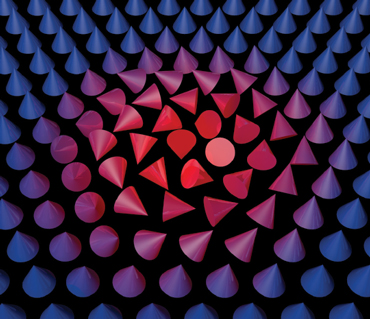
ELLA MARU STUDIO
Néel skyrmion
In a Néel skyrmion, the magnetic poles tilt outward instead of around the circle as they do in a Bloch skyrmion.
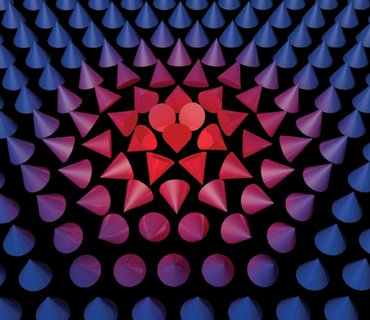
ELLA MARU STUDIO
Antiskyrmion
Newly discovered antiskyrmions are like a cross between Néel and Bloch skyrmions, and may have some advantages for memory devices, such as tolerating a range of temperatures.
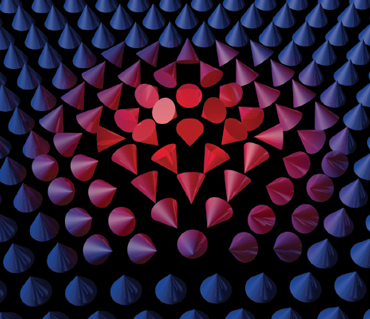
ELLA MARU STUDIO
As some try to shrink room-temp skyrmions down, others are bringing them up to speed, to make for fast reading and writing of data. In a study reported in Nature Materials in 2016, skyrmions at room temperature reached top speeds of 100 meters per second (about 220 miles per hour). Fittingly, that’s right around the fastest speed NASCAR drivers achieve. The result showed that a skyrmion racetrack might actually work, says study coauthor Mathias Kläui, a condensed matter physicist at Johannes Gutenberg University Mainz in Germany. “Fundamentally, it’s feasible at room temperature.” But to compete against domain walls, which can reach speeds of over 700 m/s, skyrmions still need to hit the gas.
Despite progress, there are a few more challenges to work out. One possible issue: A skyrmion’s swirling pattern makes it behave like a rotating object. “When you have a rotating object moving, it may not want to move in a straight line,” Hoffmann says. “If you’re a bad golf player, you know this.” Skyrmions don’t move in the same direction as an electric current, but at an angle to it. On the racetrack, skyrmions might hit a wall instead of staying in their lanes. Now, researchers are seeking new kinds of skyrmions that stay on track.
A new twist
Just as there’s more than one way to tie a knot, there are several different types of skyrmions, formed with various shapes of magnetic twists. The two best known types are Bloch and Néel. Bloch skyrmions are found in the thick, asymmetric crystals in which skyrmions were first detected, and Néel skyrmions tend to show up in thin films.
“The type of skyrmions you get is related to the crystal structure of the materials,” says physical chemist Claudia Felser of the Max Planck Institute for Chemical Physics of Solids in Dresden, Germany. Felser studies Heusler compounds, materials that have unusual properties particularly useful for manipulating magnetism. Felser, Parkin and colleagues detected a new kind of skyrmion, an antiskyrmion, in a thin layer of such a material. They reported the find in August 2017 in Nature.
Antiskyrmions might avoid some of the pitfalls that their relatives face, Parkin says. “Potentially, they can move in straight lines with currents, rather than moving to the side.” Such straight-shooting skyrmions may be better suited for racetrack schemes. And the observed antiskyrmions are stable at a wide range of temperatures, including room temperature. Antiskyrmions also might be able to shrink down smaller than other kinds of skyrmions.
Physicists are now on the hunt for skyrmions within a different realm: antiferromagnetic materials. Unlike in ferromagnetic materials — in which atoms all align their poles — in antiferromagnets, atoms’ poles point in alternating directions. If one atom points up, its neighbor points down. Like antiskyrmions, antiferromagnetic skyrmions wouldn’t zip off at an angle to an electric current, so they should be easier to control. Antiferromagnetic skyrmions might also move faster, Kläui says.
Materials scientists still need to find an antiferromagnetic material with the necessary properties to form skyrmions, Kläui says. “I would expect that this would be realized in the next couple of years.”
Finding the knots’ niche
Once skyrmions behave as desired, creating a racetrack memory with them is an obvious next step. “It is a technology that combines the best of multiple worlds,” Kläui says — stability, easily accessible data and low energy requirements. But Kläui and others acknowledge the hurdles ahead for skyrmion racetrack memories. It will be difficult, these researchers say, to beat traditional magnetic hard drives — not to mention the flash memories available in newer computers — on storage density, speed and cost simultaneously.
“The racetrack idea, I’m skeptical about,” Hoffmann says. Instead, skyrmions might be useful in devices meant for performing calculations. Because only a small electric current is required to move skyrmions around, such devices might be used to create energy-efficient computer processors.
Another idea is to use skyrmions for biologically inspired computers, which attempt to mimic the human brain (SN: 9/6/14, p. 10). Brains consume about as much power as a lightbulb, yet can perform calculations that computers still can’t match, thanks to large interconnected networks of nerve cells. Skyrmions could help scientists achieve this kind of computation in the lab, without sapping much power.
IN THEORY If found, antiferromagnetic skyrmions would move in a straight line when pushed by electric current. They would arise in materials with atoms that have alternating magnetic poles.
X. ZHANG, Y. ZHOU, M. EZAWA/SCIENTIFIC REPORTS 2016, ADAPTED BY E. OTWELL
A single skyrmion could behave like a nerve cell, or neuron, electrical engineer Sai Li of Beihang University in Beijing and colleagues suggest. In the human body, a neuron can add up signals from its neighbors, gradually building up a voltage across its membrane. When that voltage reaches a certain threshold, ions begin shifting across the membrane in waves, generating an electric pulse. Skyrmions could imitate this behavior: An electric current would push a skyrmion along a track, with the distance traveled acting as an analog for the neuron’s increasing voltage. A skyrmion reaching a detector at the end would be equivalent to a firing neuron, the researchers proposed in July 2017 in Nanotechnology.
By combining a large number of neuron-imitating skyrmions, the thinking goes, scientists could create a computer that operates something like a brain.
Additional ideas for how to use the magnetic whirls keep cropping up. “It’s still a growing field,” von Bergmann says. “There are several new ideas ahead.”
Whether or not skyrmions end up in future gadgets, the swirls are part of a burgeoning electronics ecosystem. Ever since electricity was discovered, researchers have focused on the motion of electric charges. But physicists are now fashioning a new parallel system called spintronics — of which skyrmions are a part — based on the motion of electron spin, that property that makes atoms magnetic (SN Online: 9/26/17). By studying skyrmions, researchers are expanding their understanding of how spins move through materials.
Like a kindergartner fumbling with shoelaces, studying how to tie spins up in knots is a learning process
Hi! I am a robot. I just upvoted you! I found similar content that readers might be interested in:
https://www.sciencenews.org/article/skyrmions-open-door-next-level-data-storage